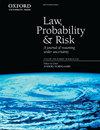Using mixture models to examine group difference among jurors: an illustration involving the perceived strength of forensic science evidence
IF 1.4
4区 社会学
Q1 LAW
引用次数: 0
Abstract
The way in which jurors perceive reports of forensic evidence is of critical importance, especially in cases of forensic identification evidence that require examiners to compare items and assess whether they originate from a common source. The current study discusses methods for studying group differences among mock jurors and illustrates them using a reanalysis of data regarding lay perceptions of forensic science evidence. Conventional approaches that consider subpopulations defined a priori are compared with mixture models that infer group structure from the data, allowing detection of subgroups that cohere in unexpected ways. Mixture models allow researchers to determine whether a population comprises subpopulations that respond to evidence differently and then to consider how those subpopulations might be characterized. The reanalysis reported here shows that mixture models can enhance understanding of lay perceptions of an important type of forensic science evidence (DNA and fingerprint comparisons), providing insight into how the perceived strength of that evidence varies as a function of the language forensic experts use to describe their findings. This novel application of mixture models illustrates how such models can be used, more generally, to explore the importance of juror characteristics in jury decision making.使用混合模型检验陪审员之间的群体差异:一个涉及法医学证据感知强度的例子
陪审员看待法医证据报告的方式至关重要,特别是在需要审查员比较物品并评估它们是否来自共同来源的法医鉴定证据的情况下。目前的研究讨论了模拟陪审员之间研究小组差异的方法,并通过对法医学证据的外行感知数据的重新分析来说明这些方法。将考虑先验定义的亚种群的传统方法与从数据推断群体结构的混合模型进行比较,从而可以检测出以意想不到的方式凝聚在一起的亚种群。混合模型使研究人员能够确定一个种群是否包含对证据做出不同反应的亚种群,然后考虑这些亚种群的特征。本文报告的再分析表明,混合模型可以提高人们对一种重要的法医科学证据(DNA和指纹比较)的理解,从而深入了解证据的感知强度如何随着法医专家用来描述其发现的语言的变化而变化。这种混合模型的新应用说明了如何使用这些模型,更普遍地,以探索陪审员特征在陪审团决策中的重要性。
本文章由计算机程序翻译,如有差异,请以英文原文为准。
求助全文
约1分钟内获得全文
求助全文
来源期刊

Law Probability & Risk
MATHEMATICSSTATISTICS & PROBABILITY&-STATISTICS & PROBABILITY
CiteScore
2.10
自引率
28.60%
发文量
8
期刊介绍:
Law, Probability & Risk is a fully refereed journal which publishes papers dealing with topics on the interface of law and probabilistic reasoning. These are interpreted broadly to include aspects relevant to the interpretation of scientific evidence, the assessment of uncertainty and the assessment of risk. The readership includes academic lawyers, mathematicians, statisticians and social scientists with interests in quantitative reasoning.
The primary objective of the journal is to cover issues in law, which have a scientific element, with an emphasis on statistical and probabilistic issues and the assessment of risk.
Examples of topics which may be covered include communications law, computers and the law, environmental law, law and medicine, regulatory law for science and technology, identification problems (such as DNA but including other materials), sampling issues (drugs, computer pornography, fraud), offender profiling, credit scoring, risk assessment, the role of statistics and probability in drafting legislation, the assessment of competing theories of evidence (possibly with a view to forming an optimal combination of them). In addition, a whole new area is emerging in the application of computers to medicine and other safety-critical areas. New legislation is required to define the responsibility of computer experts who develop software for tackling these safety-critical problems.
 求助内容:
求助内容: 应助结果提醒方式:
应助结果提醒方式:


